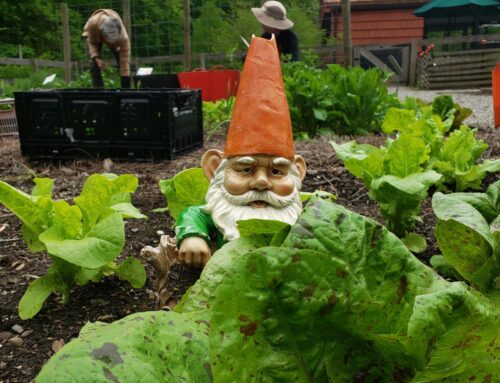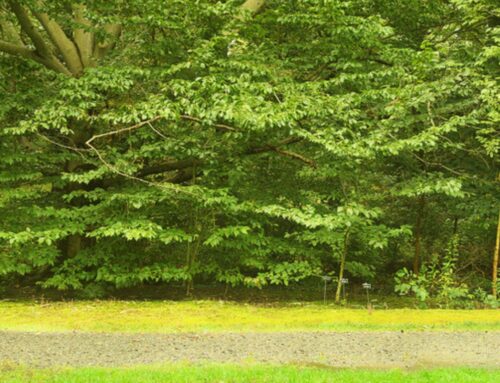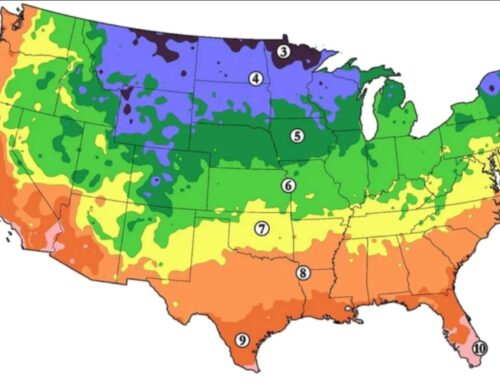Before we put our plant science hats on, humor me with a little activity. Find a piece of scrap paper and a pen/pencil and draw a flower. C’mon, it’ll be fun! Finished? Let me guess what you drew – a daisy, tulip or some kind of sunflower. Am I right? I’m going to go ahead and bet that you didn’t draw a Jack-in-the-pulpit flower (if you did, high five!).
The purpose of that exercise wasn’t to make you feel good or bad about your knowledge of flowers (or your artistic ability). It was to kick-off the concept that flowers aren’t as simple or similar as we may think. Botanists Schussler and Wandersee coined the term plant blindness as the inability to see or notice the plants in one’s own environment. Read on to have an eye-opening experience and boost your appreciation of the diversity of flowers that you may find during the spring season. I picked four Pennsylvania native plants that you may find growing in your neighborhood or local woodlands.
Facts About Bracts – Flowering dogwood (Cornus florida)
The blooms of flowering dogwood trees are a treasured part of the mid-spring landscape. The flowers provide nectar to pollinators including bees, butterflies and other insects that visit. 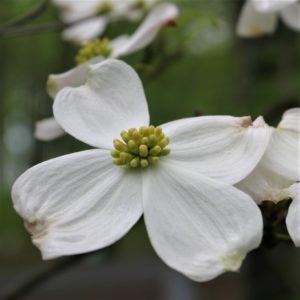 Upon closer inspection of the flower, you’ll find that there are yellow parts and white parts (or sometimes pink instead). The true flowers are the yellow parts in the center and there are usually around 20 of them clustered together. The white (or pink) parts are actually bracts not flower petals.
Upon closer inspection of the flower, you’ll find that there are yellow parts and white parts (or sometimes pink instead). The true flowers are the yellow parts in the center and there are usually around 20 of them clustered together. The white (or pink) parts are actually bracts not flower petals.
Wait, what?! Bracts are modified leaves, not petals, but they sure do a good job of fooling us. Many bracts are larger than the flowers themselves and are often showy or colorful. Flowering dogwood utilizes the notched-tipped bracts to attract pollinators to the cluster of small flowers.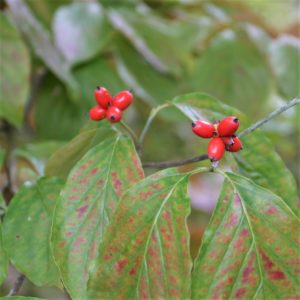
Pollination of the flowers will lead to the onset of fruit. The fruit of flowering dogwoods is red and is the perfect size to fit down the throats of our native songbirds in one gulp. I can’t say the same for the fruits of the non-native Kousa dogwood (Cornus kousa). Kousa dogwoods are native to Asia where monkeys eat their larger aggregate fruits. I haven’t seen many Asian monkeys in the trees at Tyler.
Bashful Blooms – Mayapple (Podophyllum peltatum)
Mayapples form large, dense colonies in the understory of the woods via rhizomes, or horizontal underground stems. If you look at the scientific name above (Podophyllum peltatum), it’s comprised of two words – the genus (Podophyllum) and the species (peltatum). While you might initially roll your eyes at Latin, scientific names often give you clues into certain characteristics of the plant. For example, the scientific name might have something to do with color or leaf fuzziness or even where it grows.
Peltatum is a great identifier for mayapples because it describes the way that the leaf stalk, or the petiole, is attached in the center. It’s derived from the word peltate which means shield-like or umbrella-like. Mayapple leaves are also umbrella-like in the way that they emerge in the spring. The leaves remain folded
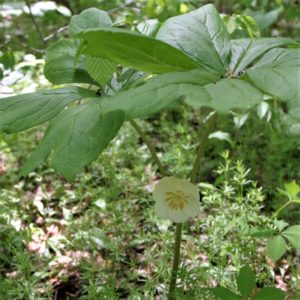
up as the stem stretches and grows and looks just like a closed-up umbrella.
Upon closer inspection of these little green umbrellas, you’ll notice that there are some stems that have one leaf and some stems that have two leaves. You mayalso notice a pattern that stems with one leaf do not have flowers while stems with two leaves do have flowers. But where are the flowers exactly? Each “two-leafer” will produce one flower – nodding beneath the foliage with waxy, white petals. If you were a flower, why would you want to hide? Hidden flowers are more protected from the elements and spring isn’t always the nicest of seasons. But don’t worry, insects like bumblebees and other long-tongued bees are able to find them and will hopefully pollinate the flowers so fruit set follows.
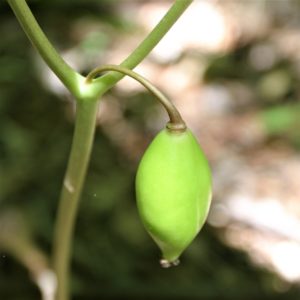
You might also have nodding flowers so that when your nodding fruit ripens, it’s in the perfect spot for a certain ravenous reptile to come find. Talk about low hanging fruit! Box turtles play an important role in moving mayapple seeds. In seed dispersal terminology, a box turtle’s relationship with mayapples falls in the“tummy traveler” category. Box turtles eat the fruit and then the real magic happens when the seeds pass through their digestive track and come out the other end. Germination rates for box turtle dispersed seeds are much higher than those of seeds that have fallen naturally.
But please be careful – do not channel your inner box turtle. While this plant may have great wildlife and medicinal value, mayapple is poisonous to eat from its rhizome to its leaves to its seeds. Toxins aside, mayapple is a great native plant for your part to full shade garden.
Jack or Jill? – Jack-in-the-pulpit (Arisaema triphyllum)
We get to learn more fun floral terminology with Jack-in-the-pulpit. Let’s take the plant’s common name (the non-Latin one) and break it down. “Jack” refers  to the club-like part partially hidden on the inside – this is called the spadix and you can find tiny flowers at its base. The “pulpit” refers to the hooded bract that surrounds the spadix – this is called the spathe. The spathe protects the flowers inside and is also sometimes colored or striped to help attract pollinators.
to the club-like part partially hidden on the inside – this is called the spadix and you can find tiny flowers at its base. The “pulpit” refers to the hooded bract that surrounds the spadix – this is called the spathe. The spathe protects the flowers inside and is also sometimes colored or striped to help attract pollinators.
The formula that you just learned about with mayapple leaves does not apply to Jack-in-the-pulpit. In Jack-in-the-pulpit, plants with one and two leaves produce flowers. While the floral structure appears the same, plants with one leaf are male (Jack) and plants with two leaves are female (introducing Jill). The sex of the flower is determined by how much energy the plant has stored in its underground corm. Turns out that it doesn’t take a lot of energy to be male. Male flowers only produce pollen which is a low energy activity so most Jack-in-the-pulpits will start out as Jacks. As the plant matures and stores up enough sugar and carbohydrate energy in its corm, it can produce some Jills since female flowers will hopefully be pollinated and produce fruit which takes a lot of energy. Once the plant fruits, it will say goodbye to Jill and say hello to Jack and start the process of storing energy again.
You might look at this flower and think – carnivorous? It does have a resemblance to the carnivorous pitcher plant. You might even get curious and flip up the top of the spathe and look in to find insects inside – carnivorous? Nope, still not carnivorous, but here’s what’s happening. Jack-in-the-pulpit is pollinated by fungus gnats, a fly relative. Those little gnats are attracted to the flowers by a faint fungal smell and head down into the spathe to lay their eggs on what they think is fungus. The inside of a Jack-in-the-pulpit spathe is a bit of a slip and slide and by the time the gnats realize that there is no fungus in sight, they have no choice but to find another way out down below.
This is the spadix’s time to shine. The floral parts of the flower are towards the base of the spadix so if that gnat happens to be inside of a male flower, it will be dusted with pollen (fingers crossed) in its efforts to find an escape route. Male flowers have a small opening at the base of the spathe that these tiny pollinators can leave through. The gnat won’t be as lucky if it finds its way into the female flower of a Jack-in-the-pulpit. Jill’s spathe lacks that exit hole and traps the insects inside with the hope that the flowers on her spadix will be pollinated as the gnat is trying to escape.
Similar to mayapple, do not channel your inner turkey when it comes to Jack-in-the-pulpit. While turkeys and other wildlife can handle eating the fruits, the plant contains calcium oxalate crystals which would be like eating fiberglass insulation. Not a good idea.
Peas in the Trees – Eastern redbud (Cercis canadensis)
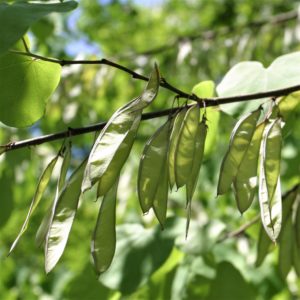 Eastern redbud trees put on quite a show in early to mid-spring. From afar it looks like the branches are absolutely covered in bright pink blooms, like a pink floral explosion. These flowers have a special shape to them, like little peas in the trees. Redbuds belong to the pea family (Fabaceae) and they have the characteristic pea family flowers – irregular flowers, with five petals forming a banner, wings and keel. If redbud flowers are pollinated, they will produce green pea-like pods that will dry later in the year to a crispy brown color.
Eastern redbud trees put on quite a show in early to mid-spring. From afar it looks like the branches are absolutely covered in bright pink blooms, like a pink floral explosion. These flowers have a special shape to them, like little peas in the trees. Redbuds belong to the pea family (Fabaceae) and they have the characteristic pea family flowers – irregular flowers, with five petals forming a banner, wings and keel. If redbud flowers are pollinated, they will produce green pea-like pods that will dry later in the year to a crispy brown color.
Let’s break those five petals down a bit. The banner is the larger petal towards the back of the flower (1). The wings are aptly named side petals that protect the keel below (2 & 3). The keel is made up of two petals which are fused together and cover the important reproductive parts of the flower (4 & 5). Each member of the pea family has their own take on these three parts. Some redbud varieties can even throw you for a loop. Cercis canadensis ‘Flame’ is a double-flowering cultivar and, while quite beautiful, does not really follow the banner/wings/keel rule.
Upon closer inspection of the tree, you’ll notice that the branches are, in fact, literally covered in bright pink blooms. Redbud has a unique way of flowering which is called cauliflory. The botanical term cauliflory is derived from Latin meaning stem flower – that helpful Latin strikes again!
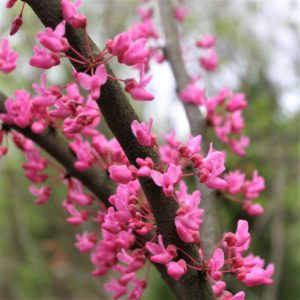 Cauliflorous flowers develop directly from the trunks and branches of mainly woody plants. You can’t help but notice this flowering pattern when you get up-close and personal with redbud trees. Most other plants only flower at the tips of their stems or branches. Redbuds aren’t the only cauliflorous plants but they are definitely the only ones that we would find in our local woodlands. Other examples of plants that exhibit cauliflory are papaya, calabash and cacao trees (where chocolate comes from).
Cauliflorous flowers develop directly from the trunks and branches of mainly woody plants. You can’t help but notice this flowering pattern when you get up-close and personal with redbud trees. Most other plants only flower at the tips of their stems or branches. Redbuds aren’t the only cauliflorous plants but they are definitely the only ones that we would find in our local woodlands. Other examples of plants that exhibit cauliflory are papaya, calabash and cacao trees (where chocolate comes from).
How’s your plant blindness doing now?! I hope that your eyes have been opened and your interest has been piqued to look more closely at the flowers that you find at Tyler Arboretum and in your own backyards or local woodlands. Flowers attract pollinators but usually attract humans at the same time.




